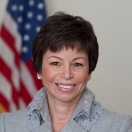
A rocket that launched raw eggs. A device that improves vision without glasses. And a mobile application for parents, created by a babysitter. Yesterday, I heard about and saw these amazing projects and more, at one of the liveliest events of the year—the third annual White House Science Fair. We welcomed 100 students from more than 40 states, representing 45 different STEM competitions and organizations.
The White House Science Fair is a key commitment in the President’s Educate to Innovate campaign to inspire more girls and boys to excel in STEM subjects. As the President has noted, “If you win the NCAA championship, you come to the White House. Well, if you're a young person and you produce the best experiment or design, the best hardware or software, you ought to be recognized for that achievement, too.”
I had the opportunity to visit several of the 30 exhibits, and met students like Jessika Baral, from Fremont, California, who created a device to strengthen eye muscles and improve peripheral vision in children and adults by as much as 87%. And Shaquiesha Davis, from Chicago, who created a mobile application, Baby B 4 Me, to help give parents a sense of comfort while their children are in the care of a babysitter or nanny. She drew upon her own babysitting experience to create this technology, and wants to one day write books to teach children how to code. And a trio of high school girls, Isabella Marie Leighton, Dalia Ivon Castillo, and Ruth Marie Moltz Long, from San Antonio, who made and launched a rocket full of eggs to a precise altitude and landed the rocket in a specific time window.
I also visited with Cassidy Wright, from Boston, who created a light-up banner made with LED lights to encourage teens to be themselves, as well as Chevanne Binns-Wallace from Baltimore, who built a underwater robot.
These young women and men are an inspiration for our efforts to encourage STEM careers, especially for girls. Throughout the Administration, including the White House Council on Women and Girls and the Office of Science and Technology Policy, we are launching initiatives that include STEM mentoring and education.
President Obama also visited several exhibits. He concluded by giving remarks to the group, and noted that yesterday was Earth Day, when the world comes together to reflect on how we can better preserve the world for future generations. Fittingly, several of the exhibits focused on energy technology.
President Obama also announced new commitments for STEM education and innovation, such as a new AmeriCorps track for STEM and new mentoring campaigns.
In his remarks yesterday to the students, President Obama said, “We’re here to celebrate these young scientists and visionaries who dream, and create, and innovate; who ask the question, why not? Why not try something better? Something that’s faster; something that helps more people. And that drive, that refusal to give up, that focus on the future is part of what makes America great.”
I was incredibly inspired and excited by all the students I met yesterday. Combined with hard work and persistence, the students showed us that the future is as limitless as their imagination.
Valerie B. Jarrett is a Senior Advisor to President Barack Obama. She is also the Chair of the White House Council on Women and Girls and oversees the Offices of Public Engagement and Intergovernmental Affairs.


